Competitive and Corporate Strategy Analysis of Qantas Airlines
VerifiedAdded on 2023/04/24
|16
|2718
|151
Report
AI Summary
This report provides a comprehensive analysis of Qantas Airlines, a major player in the global airline industry. It examines the competitive forces impacting Qantas, including the bargaining power of suppliers and customers, the threat of competitors and substitutes, and the potential for new entrants. The report details Qantas' competitive strategy, which combines cost leadership and differentiation, highlighting its strengths, weaknesses, opportunities, and threats through a SWOT analysis. It also explores the evolution of Qantas' corporate strategy, focusing on financial management, human resource practices, marketing and sales initiatives, and investments in IT and R&D. Furthermore, the report evaluates Qantas' accounting policies, specifically financial reporting and PPE asset valuation, and assesses the company's financial performance based on revenue, expenses, assets, liabilities, and equity using data from 2013 and 2018. Finally, the report offers recommendations for investors and suggests strategies for Qantas to enhance its financial position.
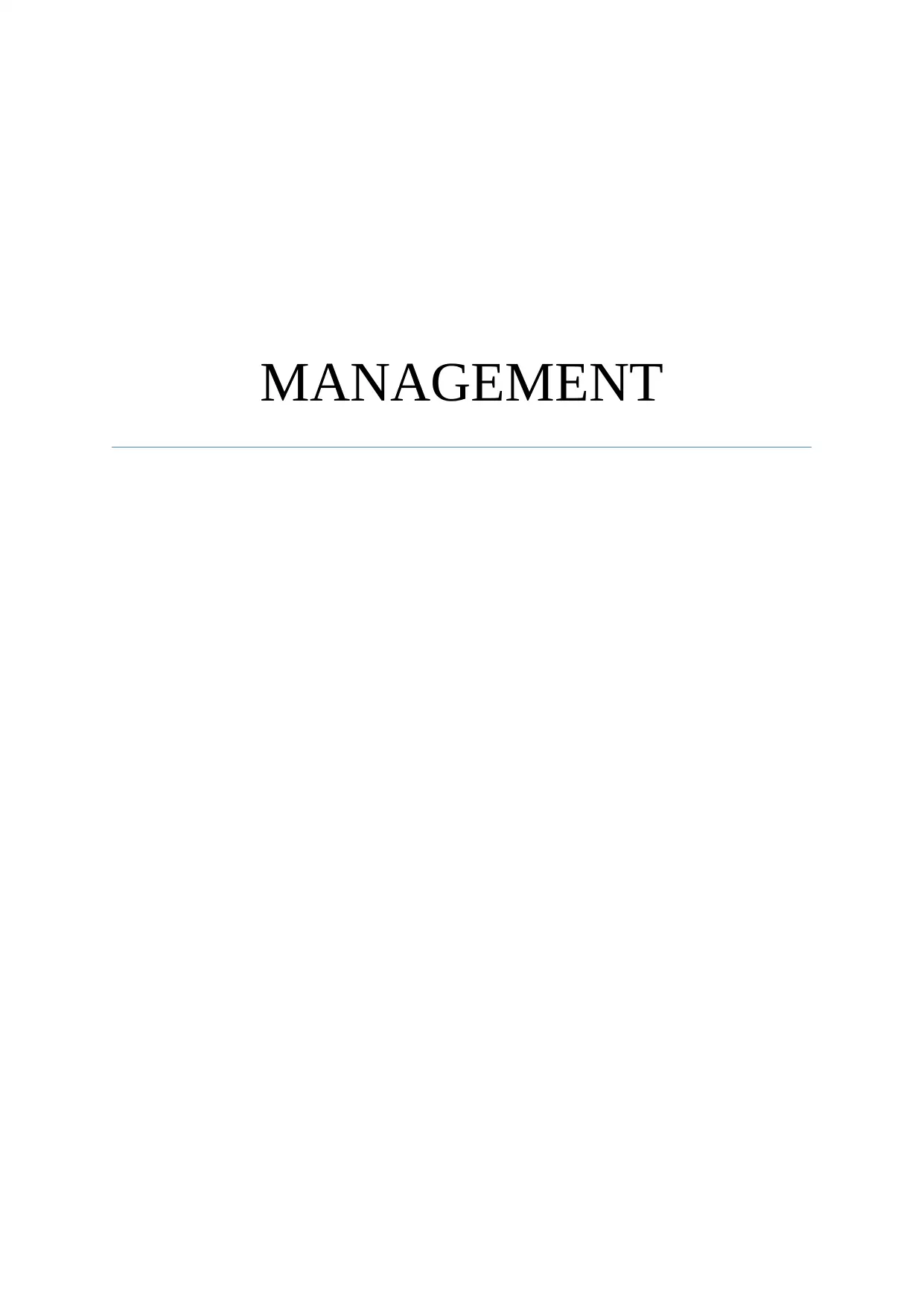
MANAGEMENT
Paraphrase This Document
Need a fresh take? Get an instant paraphrase of this document with our AI Paraphraser
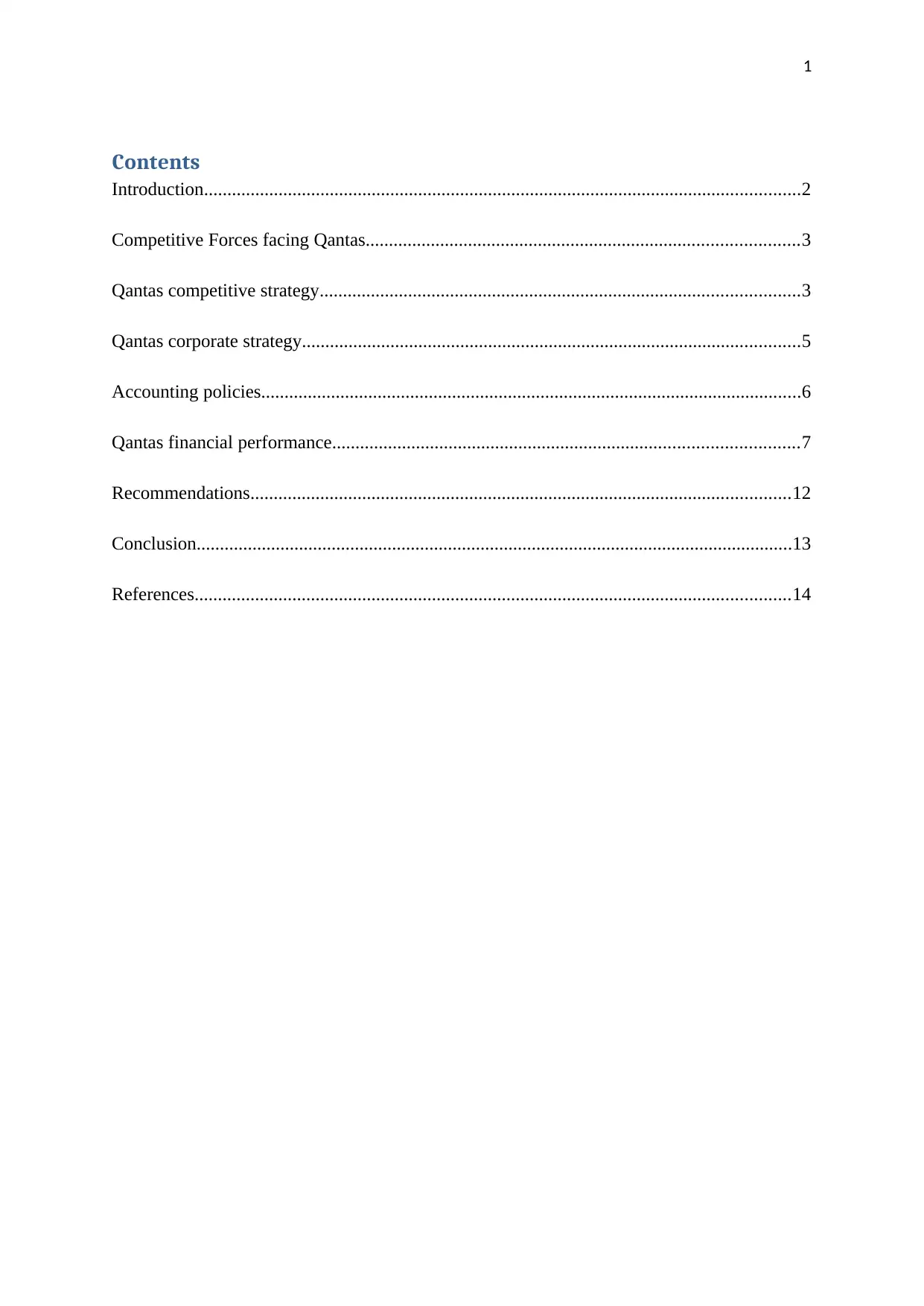
1
Contents
Introduction................................................................................................................................2
Competitive Forces facing Qantas.............................................................................................3
Qantas competitive strategy.......................................................................................................3
Qantas corporate strategy...........................................................................................................5
Accounting policies....................................................................................................................6
Qantas financial performance....................................................................................................7
Recommendations....................................................................................................................12
Conclusion................................................................................................................................13
References................................................................................................................................14
Contents
Introduction................................................................................................................................2
Competitive Forces facing Qantas.............................................................................................3
Qantas competitive strategy.......................................................................................................3
Qantas corporate strategy...........................................................................................................5
Accounting policies....................................................................................................................6
Qantas financial performance....................................................................................................7
Recommendations....................................................................................................................12
Conclusion................................................................................................................................13
References................................................................................................................................14
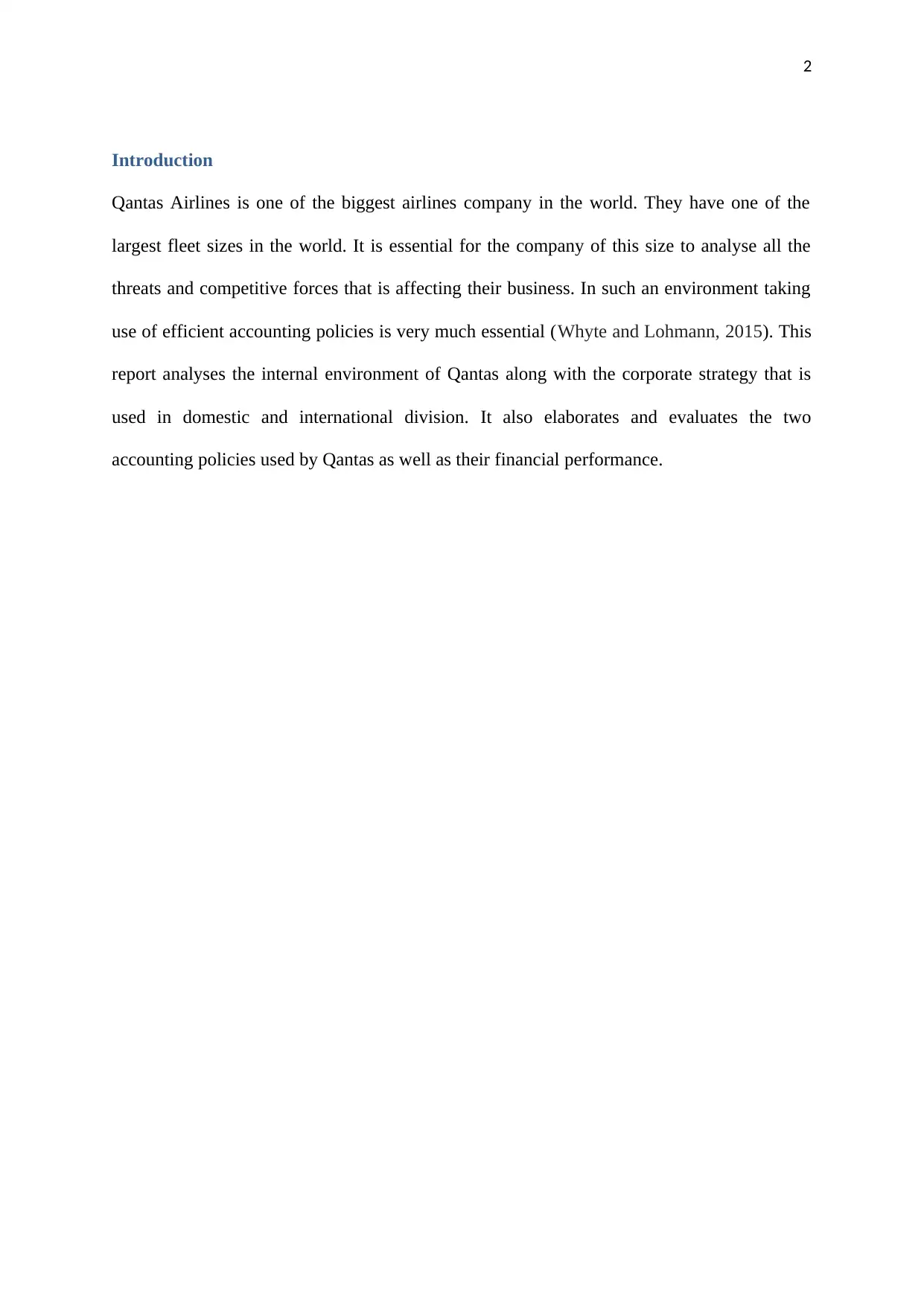
2
Introduction
Qantas Airlines is one of the biggest airlines company in the world. They have one of the
largest fleet sizes in the world. It is essential for the company of this size to analyse all the
threats and competitive forces that is affecting their business. In such an environment taking
use of efficient accounting policies is very much essential (Whyte and Lohmann, 2015). This
report analyses the internal environment of Qantas along with the corporate strategy that is
used in domestic and international division. It also elaborates and evaluates the two
accounting policies used by Qantas as well as their financial performance.
Introduction
Qantas Airlines is one of the biggest airlines company in the world. They have one of the
largest fleet sizes in the world. It is essential for the company of this size to analyse all the
threats and competitive forces that is affecting their business. In such an environment taking
use of efficient accounting policies is very much essential (Whyte and Lohmann, 2015). This
report analyses the internal environment of Qantas along with the corporate strategy that is
used in domestic and international division. It also elaborates and evaluates the two
accounting policies used by Qantas as well as their financial performance.
⊘ This is a preview!⊘
Do you want full access?
Subscribe today to unlock all pages.

Trusted by 1+ million students worldwide
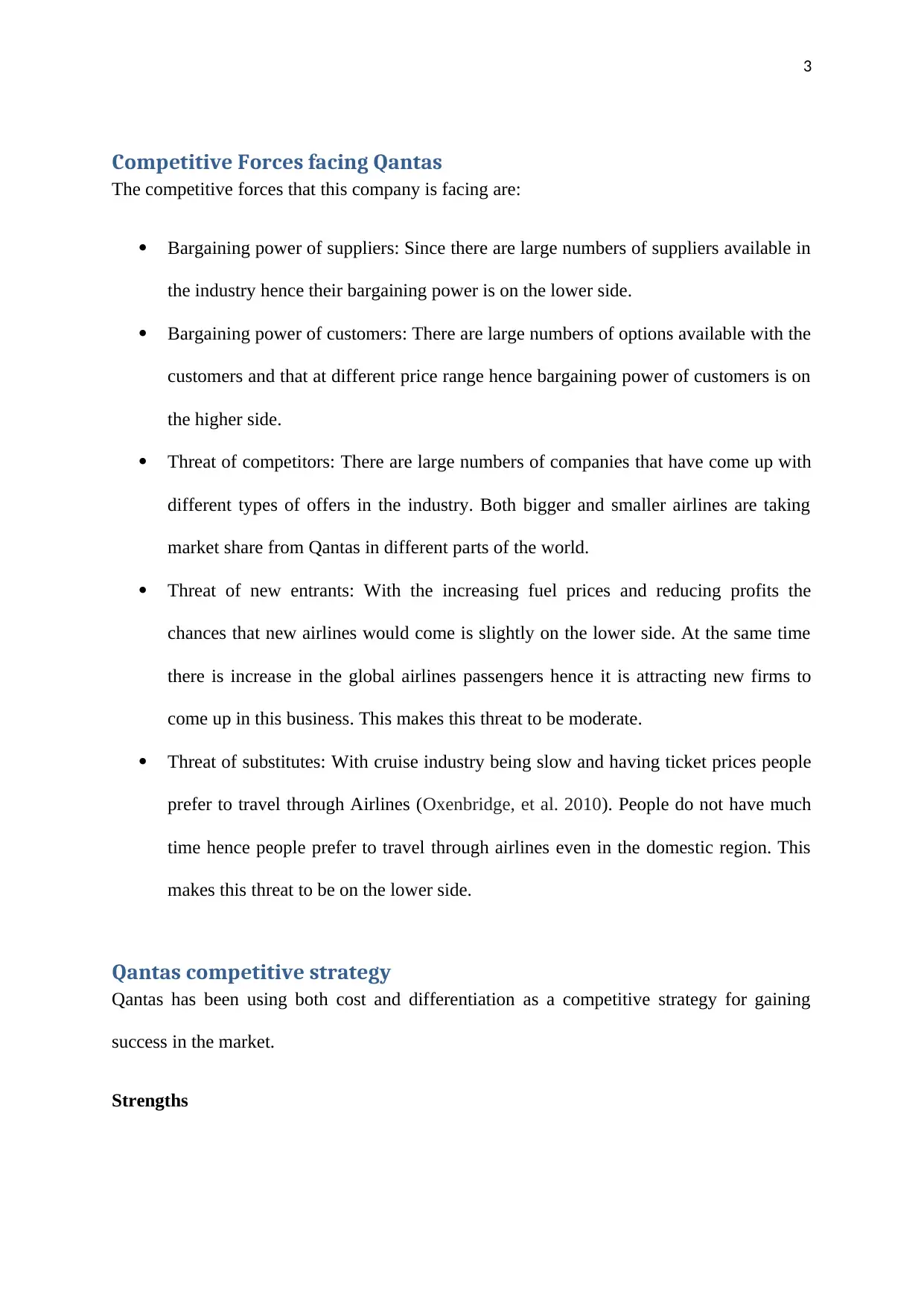
3
Competitive Forces facing Qantas
The competitive forces that this company is facing are:
Bargaining power of suppliers: Since there are large numbers of suppliers available in
the industry hence their bargaining power is on the lower side.
Bargaining power of customers: There are large numbers of options available with the
customers and that at different price range hence bargaining power of customers is on
the higher side.
Threat of competitors: There are large numbers of companies that have come up with
different types of offers in the industry. Both bigger and smaller airlines are taking
market share from Qantas in different parts of the world.
Threat of new entrants: With the increasing fuel prices and reducing profits the
chances that new airlines would come is slightly on the lower side. At the same time
there is increase in the global airlines passengers hence it is attracting new firms to
come up in this business. This makes this threat to be moderate.
Threat of substitutes: With cruise industry being slow and having ticket prices people
prefer to travel through Airlines (Oxenbridge, et al. 2010). People do not have much
time hence people prefer to travel through airlines even in the domestic region. This
makes this threat to be on the lower side.
Qantas competitive strategy
Qantas has been using both cost and differentiation as a competitive strategy for gaining
success in the market.
Strengths
Competitive Forces facing Qantas
The competitive forces that this company is facing are:
Bargaining power of suppliers: Since there are large numbers of suppliers available in
the industry hence their bargaining power is on the lower side.
Bargaining power of customers: There are large numbers of options available with the
customers and that at different price range hence bargaining power of customers is on
the higher side.
Threat of competitors: There are large numbers of companies that have come up with
different types of offers in the industry. Both bigger and smaller airlines are taking
market share from Qantas in different parts of the world.
Threat of new entrants: With the increasing fuel prices and reducing profits the
chances that new airlines would come is slightly on the lower side. At the same time
there is increase in the global airlines passengers hence it is attracting new firms to
come up in this business. This makes this threat to be moderate.
Threat of substitutes: With cruise industry being slow and having ticket prices people
prefer to travel through Airlines (Oxenbridge, et al. 2010). People do not have much
time hence people prefer to travel through airlines even in the domestic region. This
makes this threat to be on the lower side.
Qantas competitive strategy
Qantas has been using both cost and differentiation as a competitive strategy for gaining
success in the market.
Strengths
Paraphrase This Document
Need a fresh take? Get an instant paraphrase of this document with our AI Paraphraser
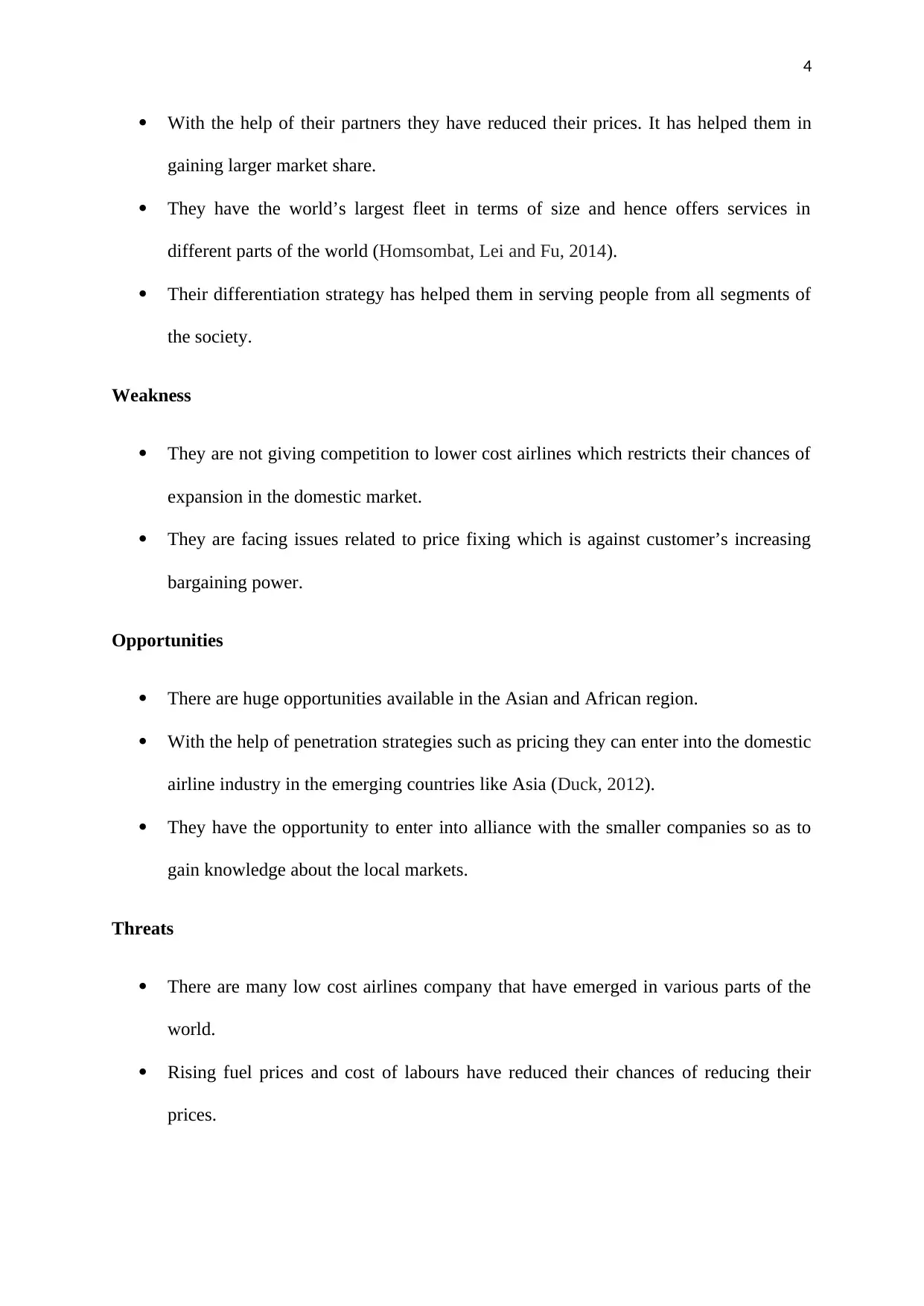
4
With the help of their partners they have reduced their prices. It has helped them in
gaining larger market share.
They have the world’s largest fleet in terms of size and hence offers services in
different parts of the world (Homsombat, Lei and Fu, 2014).
Their differentiation strategy has helped them in serving people from all segments of
the society.
Weakness
They are not giving competition to lower cost airlines which restricts their chances of
expansion in the domestic market.
They are facing issues related to price fixing which is against customer’s increasing
bargaining power.
Opportunities
There are huge opportunities available in the Asian and African region.
With the help of penetration strategies such as pricing they can enter into the domestic
airline industry in the emerging countries like Asia (Duck, 2012).
They have the opportunity to enter into alliance with the smaller companies so as to
gain knowledge about the local markets.
Threats
There are many low cost airlines company that have emerged in various parts of the
world.
Rising fuel prices and cost of labours have reduced their chances of reducing their
prices.
With the help of their partners they have reduced their prices. It has helped them in
gaining larger market share.
They have the world’s largest fleet in terms of size and hence offers services in
different parts of the world (Homsombat, Lei and Fu, 2014).
Their differentiation strategy has helped them in serving people from all segments of
the society.
Weakness
They are not giving competition to lower cost airlines which restricts their chances of
expansion in the domestic market.
They are facing issues related to price fixing which is against customer’s increasing
bargaining power.
Opportunities
There are huge opportunities available in the Asian and African region.
With the help of penetration strategies such as pricing they can enter into the domestic
airline industry in the emerging countries like Asia (Duck, 2012).
They have the opportunity to enter into alliance with the smaller companies so as to
gain knowledge about the local markets.
Threats
There are many low cost airlines company that have emerged in various parts of the
world.
Rising fuel prices and cost of labours have reduced their chances of reducing their
prices.
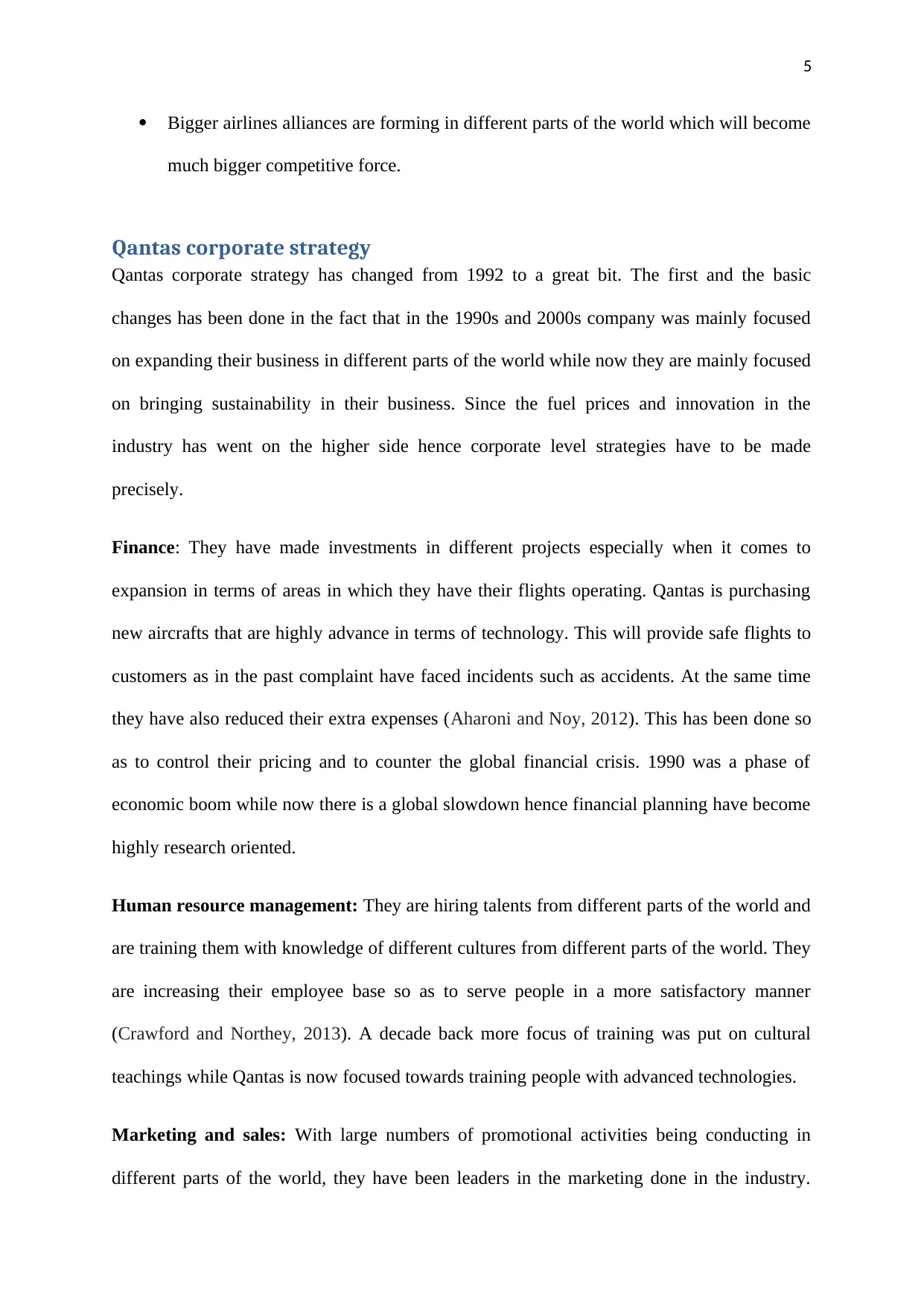
5
Bigger airlines alliances are forming in different parts of the world which will become
much bigger competitive force.
Qantas corporate strategy
Qantas corporate strategy has changed from 1992 to a great bit. The first and the basic
changes has been done in the fact that in the 1990s and 2000s company was mainly focused
on expanding their business in different parts of the world while now they are mainly focused
on bringing sustainability in their business. Since the fuel prices and innovation in the
industry has went on the higher side hence corporate level strategies have to be made
precisely.
Finance: They have made investments in different projects especially when it comes to
expansion in terms of areas in which they have their flights operating. Qantas is purchasing
new aircrafts that are highly advance in terms of technology. This will provide safe flights to
customers as in the past complaint have faced incidents such as accidents. At the same time
they have also reduced their extra expenses (Aharoni and Noy, 2012). This has been done so
as to control their pricing and to counter the global financial crisis. 1990 was a phase of
economic boom while now there is a global slowdown hence financial planning have become
highly research oriented.
Human resource management: They are hiring talents from different parts of the world and
are training them with knowledge of different cultures from different parts of the world. They
are increasing their employee base so as to serve people in a more satisfactory manner
(Crawford and Northey, 2013). A decade back more focus of training was put on cultural
teachings while Qantas is now focused towards training people with advanced technologies.
Marketing and sales: With large numbers of promotional activities being conducting in
different parts of the world, they have been leaders in the marketing done in the industry.
Bigger airlines alliances are forming in different parts of the world which will become
much bigger competitive force.
Qantas corporate strategy
Qantas corporate strategy has changed from 1992 to a great bit. The first and the basic
changes has been done in the fact that in the 1990s and 2000s company was mainly focused
on expanding their business in different parts of the world while now they are mainly focused
on bringing sustainability in their business. Since the fuel prices and innovation in the
industry has went on the higher side hence corporate level strategies have to be made
precisely.
Finance: They have made investments in different projects especially when it comes to
expansion in terms of areas in which they have their flights operating. Qantas is purchasing
new aircrafts that are highly advance in terms of technology. This will provide safe flights to
customers as in the past complaint have faced incidents such as accidents. At the same time
they have also reduced their extra expenses (Aharoni and Noy, 2012). This has been done so
as to control their pricing and to counter the global financial crisis. 1990 was a phase of
economic boom while now there is a global slowdown hence financial planning have become
highly research oriented.
Human resource management: They are hiring talents from different parts of the world and
are training them with knowledge of different cultures from different parts of the world. They
are increasing their employee base so as to serve people in a more satisfactory manner
(Crawford and Northey, 2013). A decade back more focus of training was put on cultural
teachings while Qantas is now focused towards training people with advanced technologies.
Marketing and sales: With large numbers of promotional activities being conducting in
different parts of the world, they have been leaders in the marketing done in the industry.
⊘ This is a preview!⊘
Do you want full access?
Subscribe today to unlock all pages.

Trusted by 1+ million students worldwide

6
They have utilised digital media marketing as their primary marketing strategy. Marketing
and sales has been done with the help of online website and mobile based apps. This has
helped them in reaching to larger part of the market (Mules, 2013). Along with this they are
offering many kinds of discount coupons as well as developing attractive packages for the
travellers that are flying to far across places.
IT and R&D: Apart from their purchase of technology, they have also invested a lot of
money on the research and development projects. Technology has been the major success
factor in this industry hence Qantas is allocating a lot of their money in increasing their
technology infrastructure. From booking tickets to service delivery, they are used and
modifying technologies in different sectors (Biddle, 2012). This has helped them in
delivering high quality and safe travelling services. IT is also used for the processes like
internal and external communication within the organisation. In the late 1990s more focus
was given on including the technology that made flight safe while the modern day
advancements are focused towards making technologies more automated.
Accounting policies
There are different accounting policies that are closely watched by the auditors and analyst of
the company in the airline company. The below given are the two major accounting policies
which are applied by the Qantas company: -
Financial reporting: - A company reports the periodic financial statement which are
compete, fair and conform to IFRS and Australian Accounting Standards (AASBs). Qantas
follow all these standards and ensure to maintain the same while preparing the financial
reporting for the company. In the accounting or financial, the word fair means accurate or
objective. Further, the complete financial reports include a balance sheet which reflects the
financial position of the company, the statement of income, statement of cash flows (Codjia,
They have utilised digital media marketing as their primary marketing strategy. Marketing
and sales has been done with the help of online website and mobile based apps. This has
helped them in reaching to larger part of the market (Mules, 2013). Along with this they are
offering many kinds of discount coupons as well as developing attractive packages for the
travellers that are flying to far across places.
IT and R&D: Apart from their purchase of technology, they have also invested a lot of
money on the research and development projects. Technology has been the major success
factor in this industry hence Qantas is allocating a lot of their money in increasing their
technology infrastructure. From booking tickets to service delivery, they are used and
modifying technologies in different sectors (Biddle, 2012). This has helped them in
delivering high quality and safe travelling services. IT is also used for the processes like
internal and external communication within the organisation. In the late 1990s more focus
was given on including the technology that made flight safe while the modern day
advancements are focused towards making technologies more automated.
Accounting policies
There are different accounting policies that are closely watched by the auditors and analyst of
the company in the airline company. The below given are the two major accounting policies
which are applied by the Qantas company: -
Financial reporting: - A company reports the periodic financial statement which are
compete, fair and conform to IFRS and Australian Accounting Standards (AASBs). Qantas
follow all these standards and ensure to maintain the same while preparing the financial
reporting for the company. In the accounting or financial, the word fair means accurate or
objective. Further, the complete financial reports include a balance sheet which reflects the
financial position of the company, the statement of income, statement of cash flows (Codjia,
Paraphrase This Document
Need a fresh take? Get an instant paraphrase of this document with our AI Paraphraser
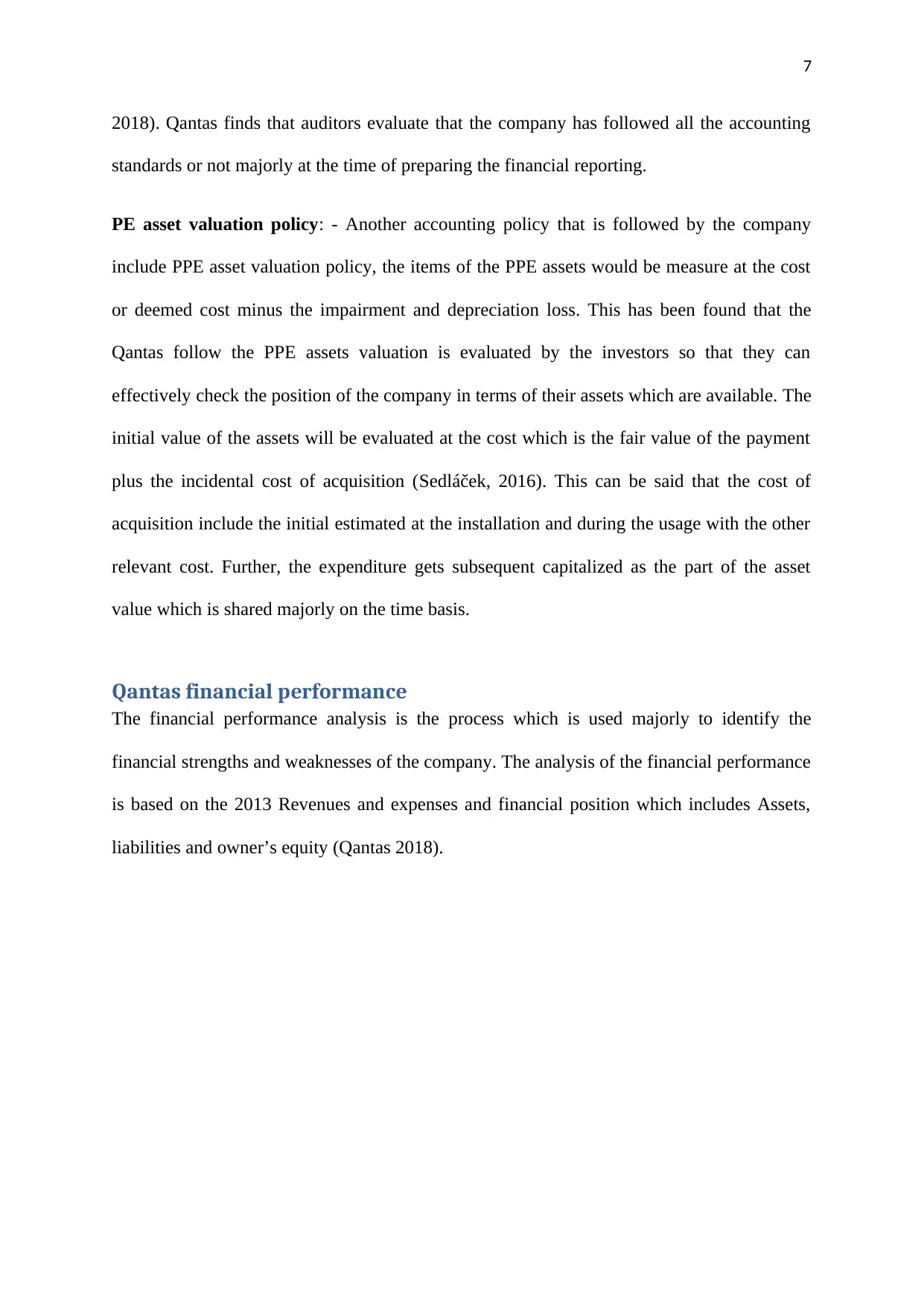
7
2018). Qantas finds that auditors evaluate that the company has followed all the accounting
standards or not majorly at the time of preparing the financial reporting.
PE asset valuation policy: - Another accounting policy that is followed by the company
include PPE asset valuation policy, the items of the PPE assets would be measure at the cost
or deemed cost minus the impairment and depreciation loss. This has been found that the
Qantas follow the PPE assets valuation is evaluated by the investors so that they can
effectively check the position of the company in terms of their assets which are available. The
initial value of the assets will be evaluated at the cost which is the fair value of the payment
plus the incidental cost of acquisition (Sedláček, 2016). This can be said that the cost of
acquisition include the initial estimated at the installation and during the usage with the other
relevant cost. Further, the expenditure gets subsequent capitalized as the part of the asset
value which is shared majorly on the time basis.
Qantas financial performance
The financial performance analysis is the process which is used majorly to identify the
financial strengths and weaknesses of the company. The analysis of the financial performance
is based on the 2013 Revenues and expenses and financial position which includes Assets,
liabilities and owner’s equity (Qantas 2018).
2018). Qantas finds that auditors evaluate that the company has followed all the accounting
standards or not majorly at the time of preparing the financial reporting.
PE asset valuation policy: - Another accounting policy that is followed by the company
include PPE asset valuation policy, the items of the PPE assets would be measure at the cost
or deemed cost minus the impairment and depreciation loss. This has been found that the
Qantas follow the PPE assets valuation is evaluated by the investors so that they can
effectively check the position of the company in terms of their assets which are available. The
initial value of the assets will be evaluated at the cost which is the fair value of the payment
plus the incidental cost of acquisition (Sedláček, 2016). This can be said that the cost of
acquisition include the initial estimated at the installation and during the usage with the other
relevant cost. Further, the expenditure gets subsequent capitalized as the part of the asset
value which is shared majorly on the time basis.
Qantas financial performance
The financial performance analysis is the process which is used majorly to identify the
financial strengths and weaknesses of the company. The analysis of the financial performance
is based on the 2013 Revenues and expenses and financial position which includes Assets,
liabilities and owner’s equity (Qantas 2018).
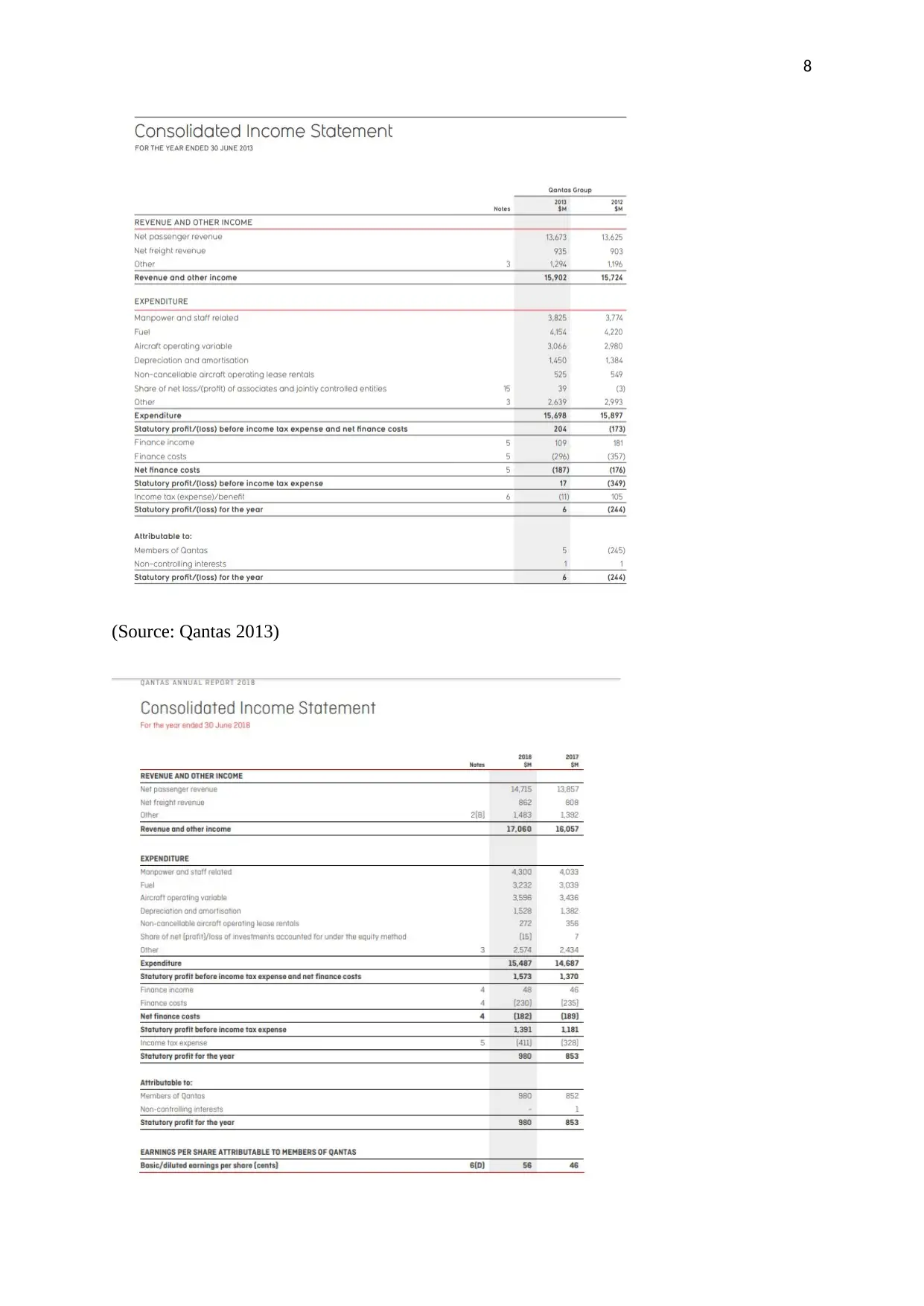
8
(Source: Qantas 2013)
(Source: Qantas 2013)
⊘ This is a preview!⊘
Do you want full access?
Subscribe today to unlock all pages.

Trusted by 1+ million students worldwide
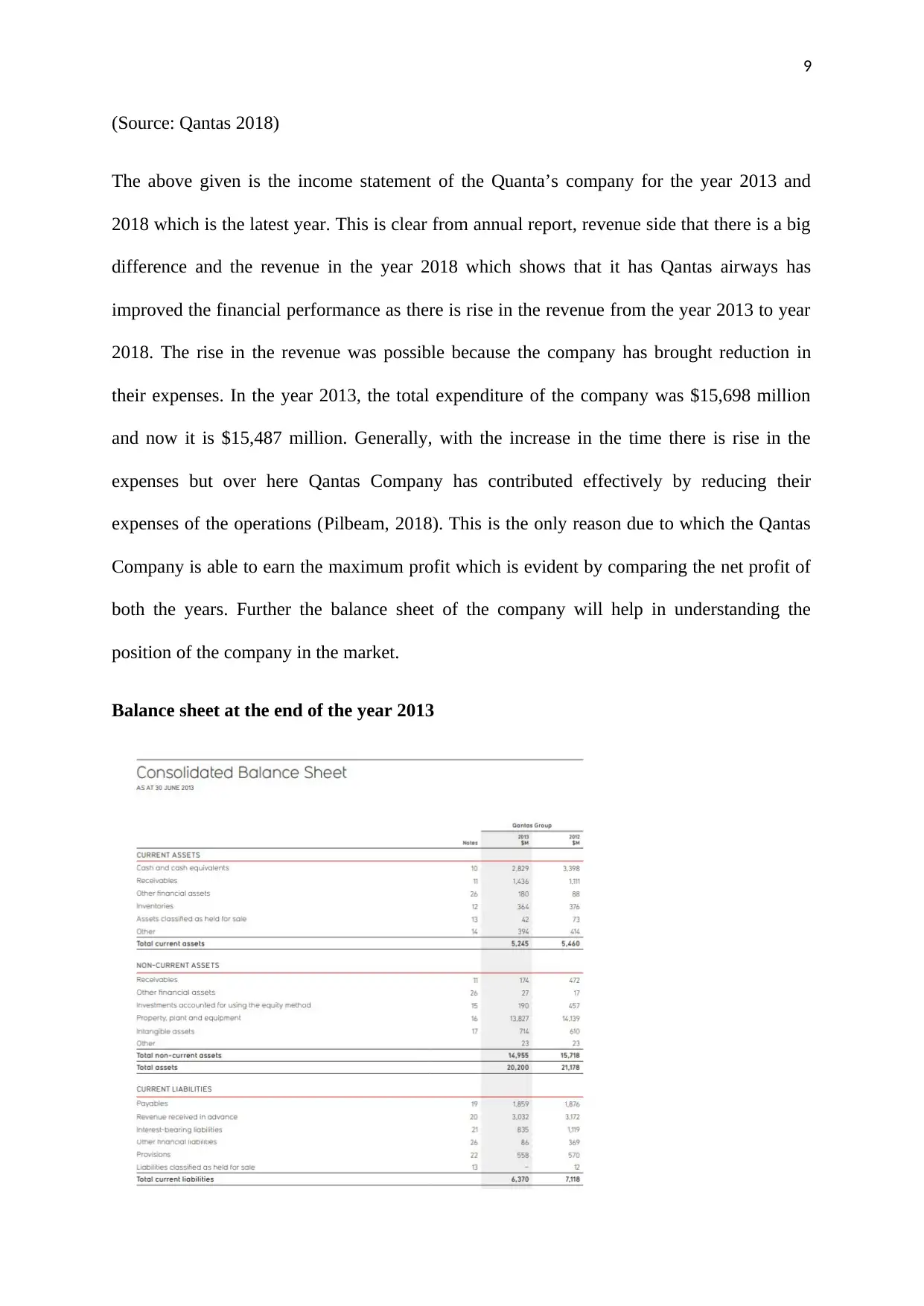
9
(Source: Qantas 2018)
The above given is the income statement of the Quanta’s company for the year 2013 and
2018 which is the latest year. This is clear from annual report, revenue side that there is a big
difference and the revenue in the year 2018 which shows that it has Qantas airways has
improved the financial performance as there is rise in the revenue from the year 2013 to year
2018. The rise in the revenue was possible because the company has brought reduction in
their expenses. In the year 2013, the total expenditure of the company was $15,698 million
and now it is $15,487 million. Generally, with the increase in the time there is rise in the
expenses but over here Qantas Company has contributed effectively by reducing their
expenses of the operations (Pilbeam, 2018). This is the only reason due to which the Qantas
Company is able to earn the maximum profit which is evident by comparing the net profit of
both the years. Further the balance sheet of the company will help in understanding the
position of the company in the market.
Balance sheet at the end of the year 2013
(Source: Qantas 2018)
The above given is the income statement of the Quanta’s company for the year 2013 and
2018 which is the latest year. This is clear from annual report, revenue side that there is a big
difference and the revenue in the year 2018 which shows that it has Qantas airways has
improved the financial performance as there is rise in the revenue from the year 2013 to year
2018. The rise in the revenue was possible because the company has brought reduction in
their expenses. In the year 2013, the total expenditure of the company was $15,698 million
and now it is $15,487 million. Generally, with the increase in the time there is rise in the
expenses but over here Qantas Company has contributed effectively by reducing their
expenses of the operations (Pilbeam, 2018). This is the only reason due to which the Qantas
Company is able to earn the maximum profit which is evident by comparing the net profit of
both the years. Further the balance sheet of the company will help in understanding the
position of the company in the market.
Balance sheet at the end of the year 2013
Paraphrase This Document
Need a fresh take? Get an instant paraphrase of this document with our AI Paraphraser
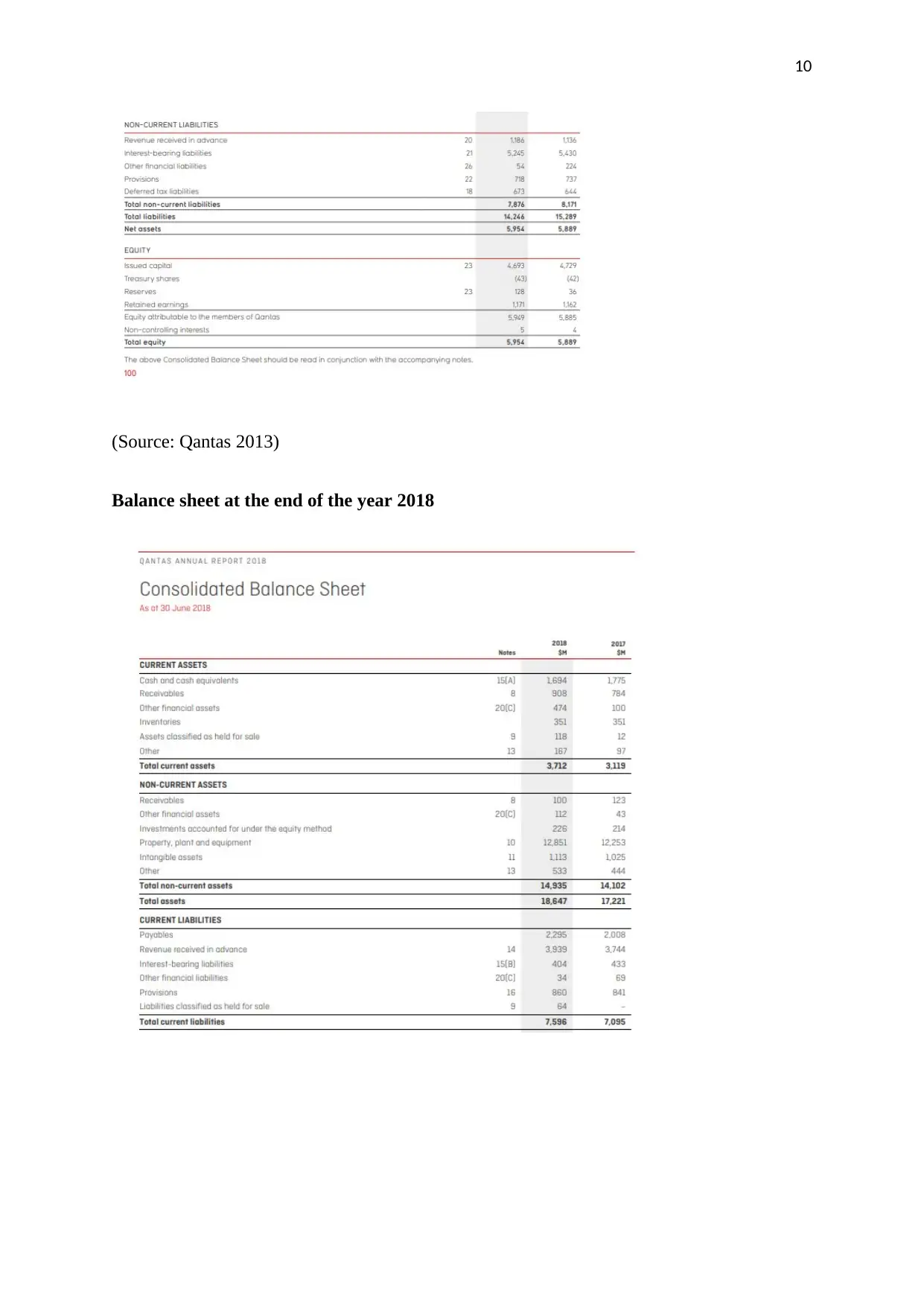
10
(Source: Qantas 2013)
Balance sheet at the end of the year 2018
(Source: Qantas 2013)
Balance sheet at the end of the year 2018
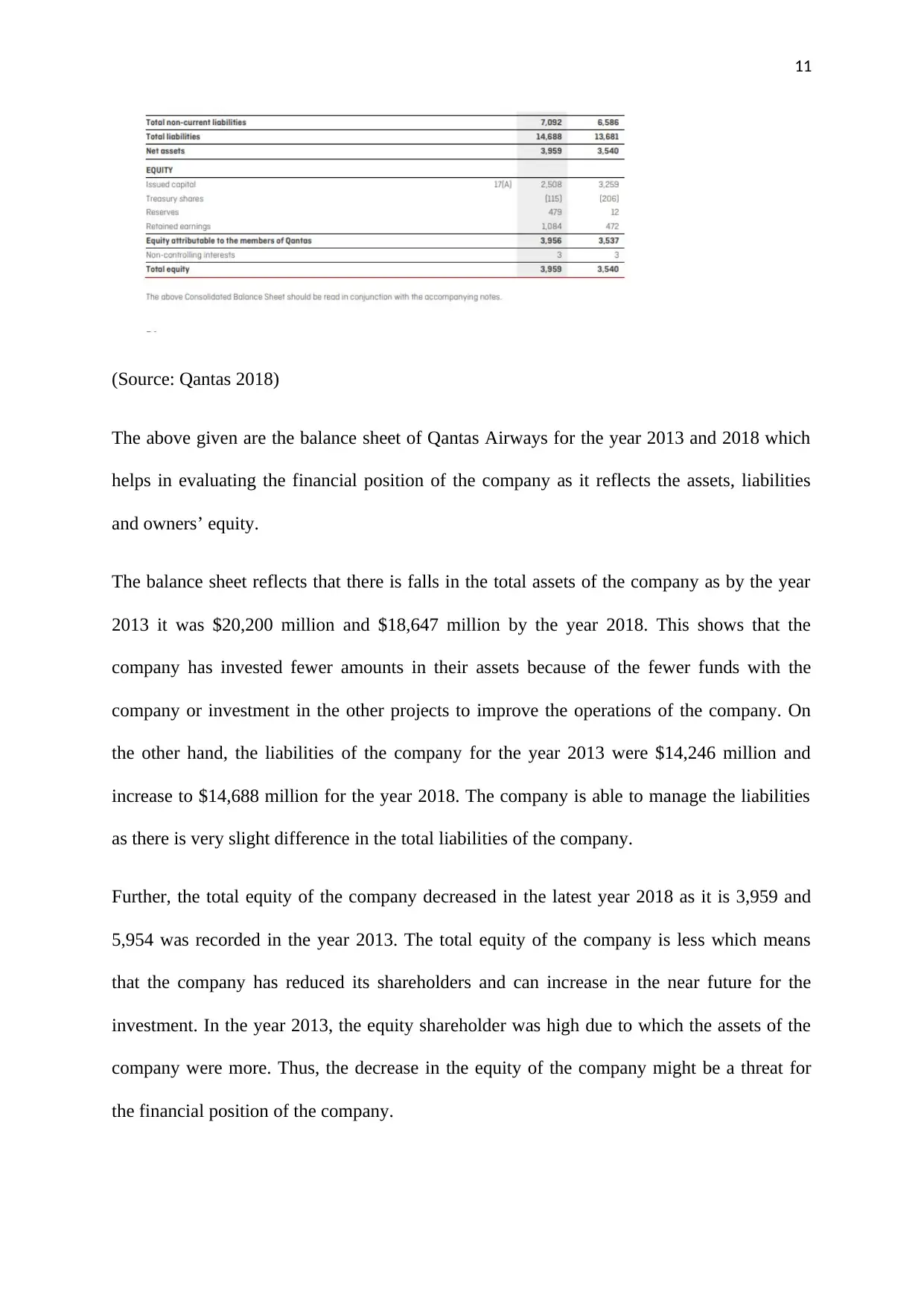
11
(Source: Qantas 2018)
The above given are the balance sheet of Qantas Airways for the year 2013 and 2018 which
helps in evaluating the financial position of the company as it reflects the assets, liabilities
and owners’ equity.
The balance sheet reflects that there is falls in the total assets of the company as by the year
2013 it was $20,200 million and $18,647 million by the year 2018. This shows that the
company has invested fewer amounts in their assets because of the fewer funds with the
company or investment in the other projects to improve the operations of the company. On
the other hand, the liabilities of the company for the year 2013 were $14,246 million and
increase to $14,688 million for the year 2018. The company is able to manage the liabilities
as there is very slight difference in the total liabilities of the company.
Further, the total equity of the company decreased in the latest year 2018 as it is 3,959 and
5,954 was recorded in the year 2013. The total equity of the company is less which means
that the company has reduced its shareholders and can increase in the near future for the
investment. In the year 2013, the equity shareholder was high due to which the assets of the
company were more. Thus, the decrease in the equity of the company might be a threat for
the financial position of the company.
(Source: Qantas 2018)
The above given are the balance sheet of Qantas Airways for the year 2013 and 2018 which
helps in evaluating the financial position of the company as it reflects the assets, liabilities
and owners’ equity.
The balance sheet reflects that there is falls in the total assets of the company as by the year
2013 it was $20,200 million and $18,647 million by the year 2018. This shows that the
company has invested fewer amounts in their assets because of the fewer funds with the
company or investment in the other projects to improve the operations of the company. On
the other hand, the liabilities of the company for the year 2013 were $14,246 million and
increase to $14,688 million for the year 2018. The company is able to manage the liabilities
as there is very slight difference in the total liabilities of the company.
Further, the total equity of the company decreased in the latest year 2018 as it is 3,959 and
5,954 was recorded in the year 2013. The total equity of the company is less which means
that the company has reduced its shareholders and can increase in the near future for the
investment. In the year 2013, the equity shareholder was high due to which the assets of the
company were more. Thus, the decrease in the equity of the company might be a threat for
the financial position of the company.
⊘ This is a preview!⊘
Do you want full access?
Subscribe today to unlock all pages.

Trusted by 1+ million students worldwide
1 out of 16
Related Documents
Your All-in-One AI-Powered Toolkit for Academic Success.
+13062052269
info@desklib.com
Available 24*7 on WhatsApp / Email
![[object Object]](/_next/static/media/star-bottom.7253800d.svg)
Unlock your academic potential
Copyright © 2020–2025 A2Z Services. All Rights Reserved. Developed and managed by ZUCOL.





